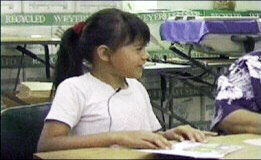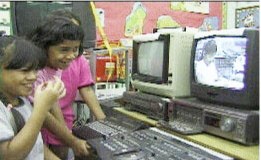Gino (pseudonym) was a first grade student referred by his classroom teacher as experiencing reading difficulties. Gino’s reading fluency was at a preprimer level, reading an average of 8 words per minute during our 3-week baseline measurement. His reading was below grade level on the Woodcock Reading Mastery Tests-Revised (Woodcock, 1987) and at the lower extreme level, .3 percentile rank, in vocabulary by the Kaufman Brief Intelligence Test (Kaufman & Kaufman, 1990). Gino was invited to participate in an individualized tutoring program, which we call Reading Rescue (see Box 1). Gino responded rapidly to the reading sessions, which involved the use of repeated passage reading (Tingstrom, Edwards, & Olmi, 1995) and a flashcard procedure for word recognition with coaching on the beginning sounds. Gino’s tutor, Ruta, the parent of a child in another class, worked with him daily for half an hour. Ruta and the other community assistants in our program had previously been trained to follow a specific protocol, with sessions audiotaped for monitoring purposes.
- ACE Reading is a remedial tutoring program, designed to give students daily one-on-one reading practice with community assistants. The program emphasizes high levels of success and uses a personal feedforward videotape to boost confidence, self-esteem, and motivation.
- ACE Reading was established in 1996, with support from the Department of Education Office of Special Education Programs and Pew Charitable Trusts.
- The program has provided tutoring services to over 150 students in grades 1-3 at four schools in both Philadelphia and Hawaii.
- The participating students are in special education or at-risk for a referral and they have been referred by their classroom teacher or reading specialist because their reading had been one or two levels below their respective grade level.
- Many students are from low-income families in a multi-ethnic urban setting, with over 80% eligible for federally subsidized lunches.
- The program has trained over 30 community partners with diverse ethnic backgrounds to help them to become reliable, effective reading tutors with positive attitudes. The program evaluate progress and outcomes systematically using curriculum-based assessment and other behavioral and academic measures.
In the fifth week of Gino’s one-on-one tutoring, we videotaped a regular tutoring session. The tape was edited into a 2-minute tape to make a feedforward video that eliminated the tutor’s assistance and illustrated the student independently reading a complete passage and mastering the sight words. It also showed Gino coping with difficulties such as sounding out the first letter of unfamiliar words and taking deep breaths to calm himself when frustrated. In the sixth and seventh weeks, Gino watched his tape daily under Ruta’s supervision at the beginning of his tutoring session. Gino, who was usually reserved, appeared to be very pleased with himself while viewing his feedforward video. He looked around with a big smile to see who else was watching. He looked as if he were about to shout, “Look at me—I can READ!” In the subsequent eighth through tenth weeks, his video was shown only on request, about twice per week.

First, the tutor helps the student read the passage, giving practice and support.

As the student improves her mastery of the passage, we take footage from which to edit her video.

Frequent praise is an important part of the tutoring process, and is included in her feedforward process.

The student enjoys watching her video, and is proud showing it to her friends.
In the last week, another video was made. This time Gino was reading 30 words per minute and had surpassed his previous feedforward mastery. Therefore, the video simply recorded about 3 minutes of his best work for positive self-review, another type of self modeling to promote the maintenance of the learned skills. This tape was given to him to watch regularly at home over the next 4 months. If he did not have the opportunity to watch this video at home, he would view it at school, at least once a month.
During intervention, Gino’s reading fluency was measured twice weekly using passages from a preprimer reader as probes. Gino’s slope (see graph), which reflected the rate of improvement, was nearly flat and indicated little improvement through the baseline and tutoring phases (weeks 1-5). During the tutoring plus feedforward phase (weeks 6-10), his rate of progress improved at a higher rate (2.3 words correct per week) than the rate during tutoring only phase (0.8 words per week). The results suggest that watching the video of himself reading fluently improved his sense of self-efficacy and motivation, enabling him to take full advantage of the reading practice sessions offered to him.

Gino’s reading Progress Chart – Long Description
To further illustrate the magnitude of the effect, our data from the other 50 or so students like Gino, who received tutoring plus video feedforward, indicate that more than 80% improved their reading skills to a level enough for them to benefit from regular classroom instruction. Not only did the participants improve reading skills as a result of daily tutoring combined with personalized feedforward video intervention but the majority of the students also showed improvement in their social and academic behaviors. One student, in particular, who used to be absent 2 or 3 days per week began to enjoy coming to school, with a substantial decrease in his absenteeism and tardiness. He also interacted noticeably better with his classmates and tutors. The value of the video feedforward process is summarized in a responsive note written by a teacher who has her two students in Reading Rescue:
“… I have seen so much growth in all areas in Kimo and Chantiel (pseudonyms)… I’m sure you feel as happy as I do when you see the two of them so interested in reading and learning since you have provided them with the tools to do so. 🙂 ! I just can’t explain how much I appreciate it!…”
About 20% of the students progressed slowly and needed an extension of the tutoring program. Some also needed specific adaptations in the video and the reading instruction to accommodate individual needs and personal learning styles.
